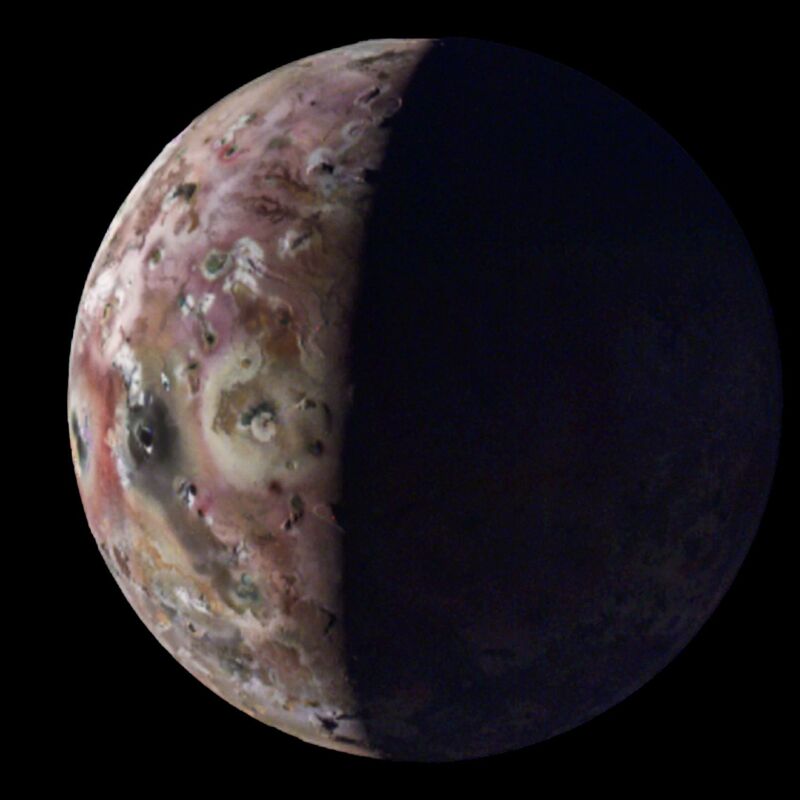
Ever since the Voyager mission sent home images of Jupiter’s moon Io spewing material into space, we’ve gradually built up a clearer picture of Io’s volcanic activity. It slowly became clear that Io, which is a bit smaller than Mercury, is the most volcanically active body in the Solar System, with all that activity driven by the gravitational strain caused by Jupiter and its three other giant moons. There is so much volcanism that its surface has been completely remodeled, with no signs of impact craters.
A few more details about its violence came to light this week, with new images being released of the moon’s features, including an island in a lake of lava, taken by the Juno orbiter. At the same time, imaging done using an Earth-based telescope has provided some indications that this volcanism has been reshaping Io from almost the moment it formed.
Fiery, glassy lakes
The Juno orbiter’s mission is primarily focused on studying Jupiter, including the dynamics of its storms and its internal composition. But many of its orbital passes have taken it right past Io, and this week, the Jet Propulsion Laboratory released some of the best images from these flybys. They include a shot of Loki Patera, a lake of lava that has an island within it. Also featured: the impossibly sheer slopes of Io’s Steeple Mountain.
Looking more closely at the lake, the Juno team found that some of the areas within it were incredibly smooth, raising the possibility that obsidian glass had formed on the surface where it had cooled enough to solidify. Given the level of volcanism on Io, this may be more widespread than the Loki Patera.
Volcanic ash would also create a relatively smooth surface, and is likely to be even more common, but it would have significantly different reflective properties.
How long has this been going on?
But we don’t have to send hardware to Jupiter to learn something about Io. A US-based team got time on the Atacama Large Millimeter Array (ALMA) and used it to record emissions from atoms in Io’s sparse atmosphere. By combining the imaging power of lots of smaller telescopes scattered across a plateau, ALMA is able to spot regional differences in the presence of specific elements in Io’s atmosphere, as well as identify different isotopes of those elements.
What can isotopes tell us? Any atoms that reach Io’s upper atmosphere are at risk of being lost to space. And, because of their relative atomic weights, lighter isotopes have a higher probability of being lost. So, it’s possible to compare the present ratio of elements in the atmosphere with the expected ratio, and we can make inferences about the history of loss of lighter isotopes. And, since the material is put into the atmosphere by volcanoes in the first place, that tells us something about the history of volcanism.
The research team focused on two particular elements: sulfur and chlorine. Sulfur has two common non-radioactive isotopes, 32S and 34S, and chlorine, its neighbor on the periodic table, has 35Cl and 37Cl. There are differences in the ratio of these isotopes throughout the bodies of the Solar System, but those differences are generally small. And, because we think we know what sort of material contributed to the formation of Io, we can focus on the ratios found in bodies that have a similar origin.
Chlorine enters the atmosphere from volcanoes primarily in the form of sodium and potassium salts. These have a very short half-life before they’re split up by exposure to light and radiation. The ALMA data indicated both these chemicals were present in localized regions, likely corresponding to active volcanic plumes. The data from the chlorine isotopes were a bit noisy, so were largely used as a sanity check for the ones obtained from sulfur isotopes.